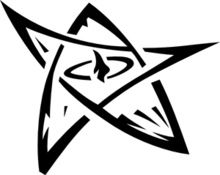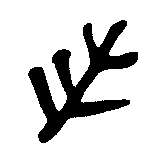Elder Sign

The Elder Sign is an icon in the Cthulhu Mythos, whose stories describe it as a form of protection against evil forces. Although not described in Lovecraft's work, he illustrated it in correspondence as a line with five branches. Mythos writer August Derleth described the Elder Sign as a warped, five-pointed star with a flaming pillar (or eye) in its center, and it is this interpretation which has become the most popular in subsequent Mythos literature.
Description
The Elder Sign is first mentioned in H. P. Lovecraft's 1926 story The Dream Quest of Unknown Kadath, although it is not described ("the farmer and his wife would only make the Elder Sign and tell him the way to Nir and Ulthar").

Lovecraft loosely described an Elder Sign only once in his writings, as given by the aged alcoholic Zadok Allen in "The Shadow Over Innsmouth" (1936): "In some places they was little stones strewed abaout—like charms—with somethin' on 'em like what ye call a swastika nowadays. Prob'ly them was the Old Ones' signs." In this story, the sign is used as a defense against Deep Ones, the story suggesting that the Deep Ones cannot harm someone protected by an Elder Sign. Although it did not appear in his books, Lovecraft drew the Elder Sign in at least one of his correspondences[1] as a single line with five shorter lines branching off.
August Derleth, who wrote several Cthulhu Mythos stories, described the Sign as being "the rough shape of a star, in the center of which there appeared to be a caricature of a single giant eye; but it was not an eye, rather a broken lozenge in shape with certain lines suggestive of flames of perhaps a solitary pillar of flame".[2] This latter description, which is featured in his 1945 novel The Lurker at the Threshold, has become the most well-known and popular version of the Elder Sign. It is the version used in Dungeons & Dragons, described in Deities and Demigods as an icon of green soapstone, and also appears in Chaosium's Call of Cthulhu role-playing game—as well as the later version published under the Open Gaming License—and in the video game Call of Cthulhu: Dark Corners of the Earth as well as in the boardgame Arkham Horror, produced by Fantasy Flight Games.
A third version of the Elder Sign, incorporating both Derleth's description and Lovecraft's drawing, appears in Lin Carter's 1976 short story "The Horror in the Gallery". This version places Lovecraft's branching design as a cartouche in the center of an oval "star stone". According to the fictional Book of Iod, one of the numerous arcane tomes mentioned in the Cthulhu Mythos, the Elder Sign is a powerful weapon against the servants of Cthulhu and the Outer Gods, and can be used to drive them off.[3]
In other media
The Elder Sign is mentioned in "Allan and the Sundered Veil", a short story found in The League of Extraordinary Gentlemen, Volume I. The short is highly inspired by the Cthulhu Mythos and describes an African woman using the sign to drive out an otherworldly being that has possessed Allan Quatermain. The sign described matches the star pattern but is a heptagram rather than a pentagram.
In the tabletop role-playing game Dungeons & Dragons, creatures from the Far Realm can sometimes be warded off by the Cerulean Sign, which is depicted as a stylized white tree with five branches on a cerulean background.[4] The depiction and use of this corresponds with those of the Elder Sign (or at least the version of the Elder Sign that has the shape of a branch or a pine tree), since the Far Realm is heavily Lovecraftian in character.
A card and dice game Elder Sign was released by Fantasy Flight Games in late 2011. Players explore a museum in the Mythos setting, and must cooperate to seal a randomly selected monster.
In The Cabin in the Woods, a five-sided swastika-like design has been crafted into the floor of the ritual chamber. Beneath it the "Ancient Ones" lie slumbering.
In Bloodborne, a rune named Eye has the exact design.
Notes
- ↑ Lovecraft, H. P. (1998). Selected Letters III. Sauk City, WI: Arkham House. p. 216. ISBN 0-87054-032-7.
- ↑ Lovecraft, H.P.; Derleth, August (2003). The Lurker at the Threshold (1st Carroll & Graf trade pbk. ed.). New York: Carroll & Graf. ISBN 0786711884.
- ↑ "Cthulhu Universalis", accessed April 18, 2011.
- ↑ Baker, Richard (2005). Lords of Madness. Holtzbrinck Publishing. pp. 195, 211. ISBN 978-0786936571.
References
- Derleth, August; H. P. Lovecraft (2003) [1945]. The Lurker at the Threshold. Pub Group West. ISBN 0-7867-1188-4.
- Harms, Daniel (1998). "Elder Sign". The Encyclopedia Cthulhiana (2nd ed.). Oakland, CA: Chaosium. pp. 98&ndash, 99. ISBN 1-56882-119-0.
- Petersen, Sandy. Call of Cthulhu (5th ed.). Oakland, CA: Chaosium. ISBN 1-56882-148-4.
- Moore, Alan. The League of Extra Ordinary Gentlemen Volume I. ISBN 1-56389-665-6.